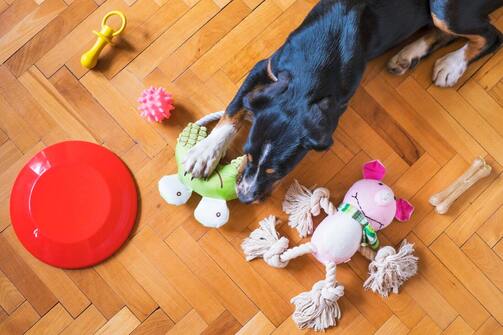“Resource guarding is a behaviour motivated by the defence of valuable resources, as perceived by the dog. It can be displayed as a purely defensive response (e.g., running away with valuable items) or as an overtly aggressive response (e.g., growling, barking, lunging and biting).” Resource guarding in dogs is complex and straightforward a the same time. Our dogs like certain items, and yet sometimes they like those items so much they can show some pretty intimidating behaviours around them. The above quote from the Frontier Journal of Veterinary Science points out something key. It is what the DOG perceives as important, not what WE think they should like. This is where it gets a little bit more complicated. We can all think of the main things a dog may guard.
But we often see the guarding spread to more complicated items, such as:
When it starts becoming something we do not expect from our dogs, it can get hard to think ahead and stop incidents from occurring. So what can we do? How do we prevent, manage, and keep our dog’s from being protective, stressed and defensive over their things? PREVENTION If we can stop our dogs from practising guarding in the first place, then we’re in for an easier ride. Despite what you may have heard, fiddling with your puppy’s food, taking it off them when they are young, is not the way to go. There is a belief that dog’s should just relinquish what they have for us, if we ask, but protecting your things (especially food), is a perfectly normal behaviour. In a more wild setting, if you just gave up those valuable things (food, water, shade), your survival would be jeopardised. So when we teach our puppies at an early age that we ARE going to interfere, they are more likely to start guarding sooner. What we need to teach our puppies is that whenever we interact with their valuable items, something better will happen for them. We need to make it worth their while to give up goodies. Trading: If your puppy steals a sock– chasing after them will only make the sock more valuable. Have an exciting, accessible toy that you can give them instead. When they see what you’ve got and eventually choose the more fun thing, have a great game of tug! This gives them a good feeling for giving the first item over. If you HAVE TO approach a dog when they’re having a meal (we highly recommend just leaving them alone), bring better goodies to drop into their bowl. This will help your puppy learn that someone coming closer means something awesome, and there's no need to worry. By making the puppy’s choices mutually beneficial i.e. giving things up is MORE valuable than keeping it, you will be setting yourself up for less guarding to occur. WHAT DOES THE START OF GUARDING LOOK LIKE? Guarding behaviour starts small, and then progressively can increase in intensity.
So while some people think chasing a dog down who isn’t giving something over is a bit of a game, not listening to the more subtle communication that a dog is being possessive can lead to much more severe responses to make sure they get heard. MANAGEMENT Sometimes, as hard as we try, behaviours occur and we have to work with it. When behaviours happen and there isn’t the training to back it up, management techniques are the most important thing you can incorporate into your routine around your dogs. Behaviour that is rehearsed happens more often, If our dogs continue to practice any behaviour, in any situation, and it works to their desires, in this case, getting other people/dogs etc. away from their things, the more they are likely to perform the behaviour again in the same circumstance. It can also lead to the behaviours happening in different environments: called generalising. This is why we often see dogs who start with guarding one type of thing, and then it spreads to other items.
Management refers to changing the environment to ensure that your dog is set up for success. This could mean a multitude of things such as:
Management requires us to be aware of what our dogs are likely to do, and prevent them from doing it. This decreases the levels of stress our dog feels on their day to day and gives us breathing room to think about the training protocols we may need to implement. Sometimes, owners find that management is all they need to do to feel safe and have their dogs feel comfortable. In more extreme cases, you have to put in a training plan to help the dog learn that they don’t need to guard. In these instances, it is important to get in touch with a professional who knows the correct steps to take. Rushing the process or doing it wrong could increase the intensity of the behaviour and potentially put you at risk. To wrap it up, here are a few things to remember about your possessive dog.
And a really important one: YOU ARE NOT ALONE
3 Comments
Sarah Endres
20/6/2023 03:55:47 pm
Crating, tethers, and baby gates are all good management techniques and to start learning and integrating.
Reply
Danny
21/6/2023 09:28:33 pm
Want to make money by offering virtual event planning services? <a href="https://cdndn.com/srv.html?id=5530259&pub=2659821" target="_blank">click here</a> and uncover strategies to assist clients in organizing successful virtual events.
Reply
Leave a Reply. |
AuthorsArticles created by the team at Allsorts Dog Training, Bay of Plenty, New Zealand Our Library
All
|


 RSS Feed
RSS Feed